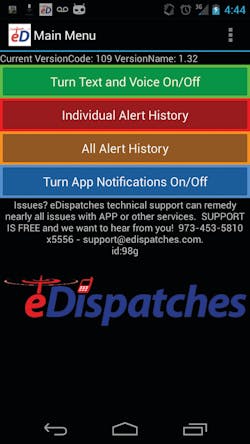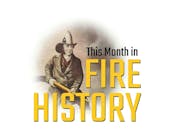The Fire Service Technology article in the March issue of Firehouse® reported specifically about devices that use the Apple iOS operating system, such as iPhones and iPads. This article focuses on smartphones and tablets for the Android operating system.
Depending on which business article you read, the market share between the Apple iOS (iPhone, iPad, iPod, etc.) and the Android operating system are close. An article posted by Reuters in March 2013 predicted that sales of Android devices, both smartphones and tablets, will exceed the iPhone and iPad this year.
There are very important discussions about app development for each of the devices. In the article “Android Is Bigger, But Here’s Why Apple Is Still the Undisputed App Cash King” on Wired.com in December 2012, reporter Sarah Mitroff explains that her research has shown that Apple has a restrictive development process that requires a developer to jump through a lot of hoops (quality control) to be able to develop and distribute the app. This translates to a potentially better quality app. This results in applications that are less ‘buggy’ on the Apple iOS system because of this tighter control. From a developer’s perspective, the Android system is open source and makes the accessibility and development/distribution of apps much easier. This means that the opportunity for the new development of the app that you are looking for may have a better chance on the Android side of the discussion.
What’s ahead
Android smartphones and tablets have some impressive devices that are on the market and exciting new devices that will be released this year. Most of the promising apps are made on both Android and Apple iOS platforms or they have a similar program that works very much the same. The previous article referenced the use of tablets in the fire apparatus, used on incidents, as a vehicle locator and for fire prevention inspections; this functionality is very much the same with the Android devices. The app download process is similar and some apps are free, some are inexpensive, and then there are others that require subscriptions and can be costly.
How to find applications for an Android device:
1. Set up an account through Google. This will be required, especially if you wish to purchase an app.
2. Click on the “Play Store” icon on the Android home screen.
3. Select the search function by pressing the magnifying glass at the top of the screen display.
4. Enter the name or category of app you are looking for.
5. Once the apps appear, you can select it for more information or you can simply install the app.
6. If the app is free, it will just say “INSTALL.”
7. If the app has a cost, the price of that app will displayed.
8. When you choose to install, you will be asked to login to your Google account; once successful, the app will be installed.
9. Open the app and follow the instructions.
Help for responders
Here is a sampling of Android apps that I came across when searching:
Response Related
• eDispatches – Receive text and or voice dispatches as well as an optional audio monitoring feature. Also incorporates a Priority Blast message or mass-messaging feature.
• One of the new and impressive programs for devices with the Android system is the Streetwise CADlink (www.streetwisecadlink.com) from Hangar 14 Solutions, which provides comprehensive information in the way of response data through computer-aided dispatch (CAD), critical maps and more to devices operating in the field.
• Cadpage (linked to Active 911) – Essential dispatch and response information. Provides mapping, routing and automatic vehicle locator functionality.
• Hybrid Auto Extrication Guide – Provides clear, zoomable vehicle schematics indicating high-power locations, airbag sensors and safe cut points.
• NIMS ICS Guide – The National Incident Management System (NIMS) Incident Command System (ICS) guide in app format.
• ESRI ArcGIS and Collector – Geographic information system (GIS) applications that provide a way to use GIS information.
• CMC Rope Rescue Field Guide – Rope rescue guide with charts, diagrams and how-to instructions.
• Search and Rescue App – An app that uses location functionality to identify where a searcher has searched.
• GPS Grid Reference App – An app that provides GPS grid reference in the field.
Weather Related
The Weatherbug, The Weather Channel, National Oceanic and Atmospheric Administration (NOAA) Radio and Lightning Locator apps are on both platforms and are as referenced in the March article.
• Storm Shield – A detail-rich app with weather radar and location-based alerts.
• NOAA Radar and Alerts – A live wallpaper that displays information directly on the smartphone or tablet.
• Radar Alive – Brings detailed live radar from every state andU.S.territory.
Preparedness Related
The Federal Emergency Management Agency (FEMA) app is available on both operating platforms.
• American Red Cross Wildfire Preparedness – Be ready for a wildfire. Be notified for wildfires in your area as well as dangerous wildfire weather.
• American Heart Association First Aid and CPR – An app for first aid and CPR information.
• Life360 Family Locator – Uses GPS technology to locate family members and also receive notification of family members in distress.
• Disaster Survival Guide – A guide that outlines what to do before, during and after a disaster.
• Crisis Direct – An app that helps get the word out to those in need of assistance.
Chemical/Hazmat Related
• Chemical Reactions Balancer – A reliable and powerful chemical balancer tool.
• Cargo Decoder – A quick lookup tool that provides information on substances being transported.
• WISER for Android – Wireless Information System for Emergency Responders (WISER) is a resource for hazardous materials incidents.
• Hazmat Pocket Guide – A great app for hazmat reference in the field.
Disaster Related
• Earthquake Apps – There are many apps for earthquakes such as (Latest Quakes, World Quakes, GeoNet Quake, etc.)
• Disaster Alert – An app that displays disasters happening around the world.
• Natural Disaster Monitor – Provides close to real-time information on natural disasters around the world.
• Disaster Medicines for Disasters – Medicine information focused specifically on disaster situations.
• ubAlert – Global emergency warning platform that reports the location and severity of disasters in real time.
Training/Reference Related
• CERT Fire Safety – An app that provides all of the information in an easy-to-understand format for fire safety training in the Community Emergency Response Team (CERT) program.
• EMS Pocket Drug Guide – A great resource for anyEMSprovider.
• EMT Tutor - A pocket app that provides information to help the new EMT.
• Firefighter Pocket Book Lite – This app provides flash cards, study guides, skill sheets and more.
• Knots 3D – Instruction app that displays how to tie knots easily.
• Knotting/Splicing Ropes and Cordage – This app provides all the information you need for knotting, splicing and cordage.
• Fire Officer Field Guide – An interactive field app designed to provide information to the fire officer.
Just for Fun
• Fire Trucker – Drive the fire truck to the fire quickly to help put out the fire.
• Kids Fire Truck Games – Just what it implies, fire truck games for kids (in 3D)
• Talking Max the Firefighter – An interactive app for children that recognizes the spoken word and responds as well as interaction with screen selections.
Conclusion
The new development of device technology (smartphones and tablets) combined with the buildout of a new public safety broadband wireless network – the First Responder Network Authority (“FirstNet”) – will require all public safety agencies to take a hard look at near-term and long-term strategies on how these devices may be implemented into daily operations. In some cases, the right strategy will provide more functionality (situation awareness, photo/historical documentation, field inspections, training, etc.) at a fraction of the cost previously spent. The devices that will likely be successful in the public safety field will be those that can operate on both the commercial and public safety broadband wireless networks. More to come.
For more news and training on technology and communications, visit: http://www.firehouse.com/topics/technology-communications.
CHARLES WERNER, EFO/CFO, a Firehouse® contributing editor, is a 39-year veteran of the fire service and chief of theCharlottesville,VA, Fire Department. He serves on the Charlottesville Regional Emergency Communications Management Board, Virginia Statewide Interoperability Executive Committee, Virginia Secure Commonwealth Panel, Department of Homeland Security (DHS) SAFECOM Executive Committee, National Alliance for Public Safety GIS, National Information Sharing Consortium and International Association of Fire Chiefs (IAFC) Technology Council. He was recently appointed by DHS Secretary Janet Napolitano to the Homeland Security Information Network (HSIN) Advisory Committee. Werner is a past president of the Virginia Fire Chiefs Association.

Charles Werner
CHARLES WERNER, who is a Firehouse contributing editor, is a 45-year veteran of public safety. He served with the Charlottesville, VA, Fire Department for 37 years, serving the past 10 years as chief. Following retirement, Werner served for two years as senior adviser and acting deputy state coordinator for the Virginia Department of Emergency Management. He has chaired: DHS SAFECOM Executive Committee; IAFC Technology Council; National Information Sharing Consortium; and DHS/White House Incident Management Information Sharing SubCommittee. Werner currently serves as the director of DroneResponders Public Safety Alliance, chair of the National Council on Public Safety UAS and chair of the Virginia Secure Commonwealth UAS Sub Panel.








